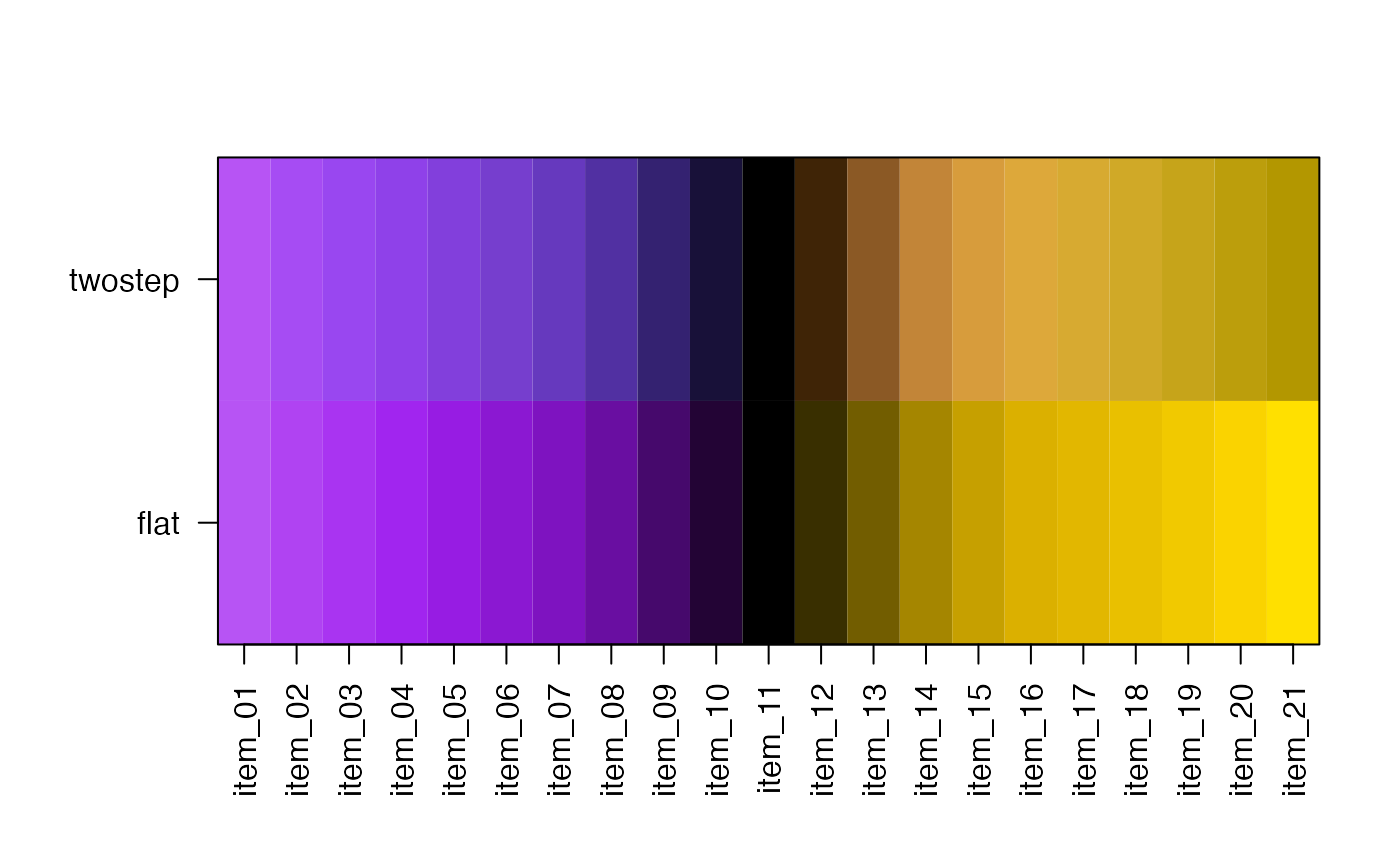Create two-step linear gradient by gradually blending two linear color gradients
Usage
twostep_gradient(
color1 = NULL,
color2 = NULL,
n = 11,
lite = TRUE,
defaultBaseColor = NULL,
adjust = 1.5,
do_fixYellow = TRUE,
debug = FALSE,
...
)Arguments
- color1
charactercolor or name of a recognized color gradient.- color2
charactercolor or name of a recognized color gradient; or whencolor2=NULLthen the hue ofcolor1is shifted to emulate the effect of having a similar neighboring color hue. In this case the inputcolor1is used ascolor2to become the primary output color.- n
integernumber of gradient colors to return. Whenn=0orn=NULLthe output is a color function.- lite
logicalindicating whether the background color should be white, or whenlite=FALSEthe background color is black.- defaultBaseColor
characterused to define a specific background color, and therefore overrideslite.- adjust
numericvalue used to adjust the relative weight betweencolor1andcolor2, where values higher than 1 favorcolor2and negative values, or values less than 1 favorcolor1.- do_fixYellow
logicalindicating whether to calljamba::fixYellow()which fixes the greenish hue that sometimes results from what is intended to be pure yellow.- debug
logicalindicating whether to create a plot to show the color blending steps.- ...
additional arguments are passed to
jamba::getColorRamp().
Details
This function is intended to produce a two-step linear gradient
effect, similar to the strategy used by RColorBrewer, but
without specific color constraints. See examples.
This function takes two color gradients and blends them
using a weighting scheme that begins with 100% color1, and
gradually becomes 100% color2.
The input color1 and color2 can be any input recognized
by jamba::getColorRamp(). For example a single color can
be used to create a gradient, or the name of a known color
gradient can be used, for example "Reds" will refer
to RColorBrewer palette "Reds". See the examples.
In general most gradients can be blended using this function to produce a new color gradient where both the visual intensity and color hue vary along the gradient, making each color step more visibly distinct than when only the visual intensity changes.
When supplying a single color as input to color1 or color2
it sometimes works best to alter the brightness of one or both
colors so the intermediate gradients have similar intensities.
Experimenting with debug=TRUE is recommended.
See also
Other colorjam gradients:
col_div_xf(),
col_linear_xf(),
make_jam_divergent()
Examples
ts <- twostep_gradient("yellow", debug=TRUE)
 #> w1 w2
#> 1 1.00000000 0.0000000
#> 2 1.00000000 0.0000000
#> 3 0.83805248 0.1619475
#> 4 0.68593553 0.3140645
#> 5 0.54433105 0.4556689
#> 6 0.41408666 0.5859133
#> 7 0.29629630 0.7037037
#> 8 0.19245009 0.8075499
#> 9 0.10475656 0.8952434
#> 10 0.03703704 0.9629630
#> 11 0.00000000 1.0000000
#> w1 w2
#> 1 1.00000000 0.0000000
#> 2 1.00000000 0.0000000
#> 3 0.83805248 0.1619475
#> 4 0.68593553 0.3140645
#> 5 0.54433105 0.4556689
#> 6 0.41408666 0.5859133
#> 7 0.29629630 0.7037037
#> 8 0.19245009 0.8075499
#> 9 0.10475656 0.8952434
#> 10 0.03703704 0.9629630
#> 11 0.00000000 1.0000000
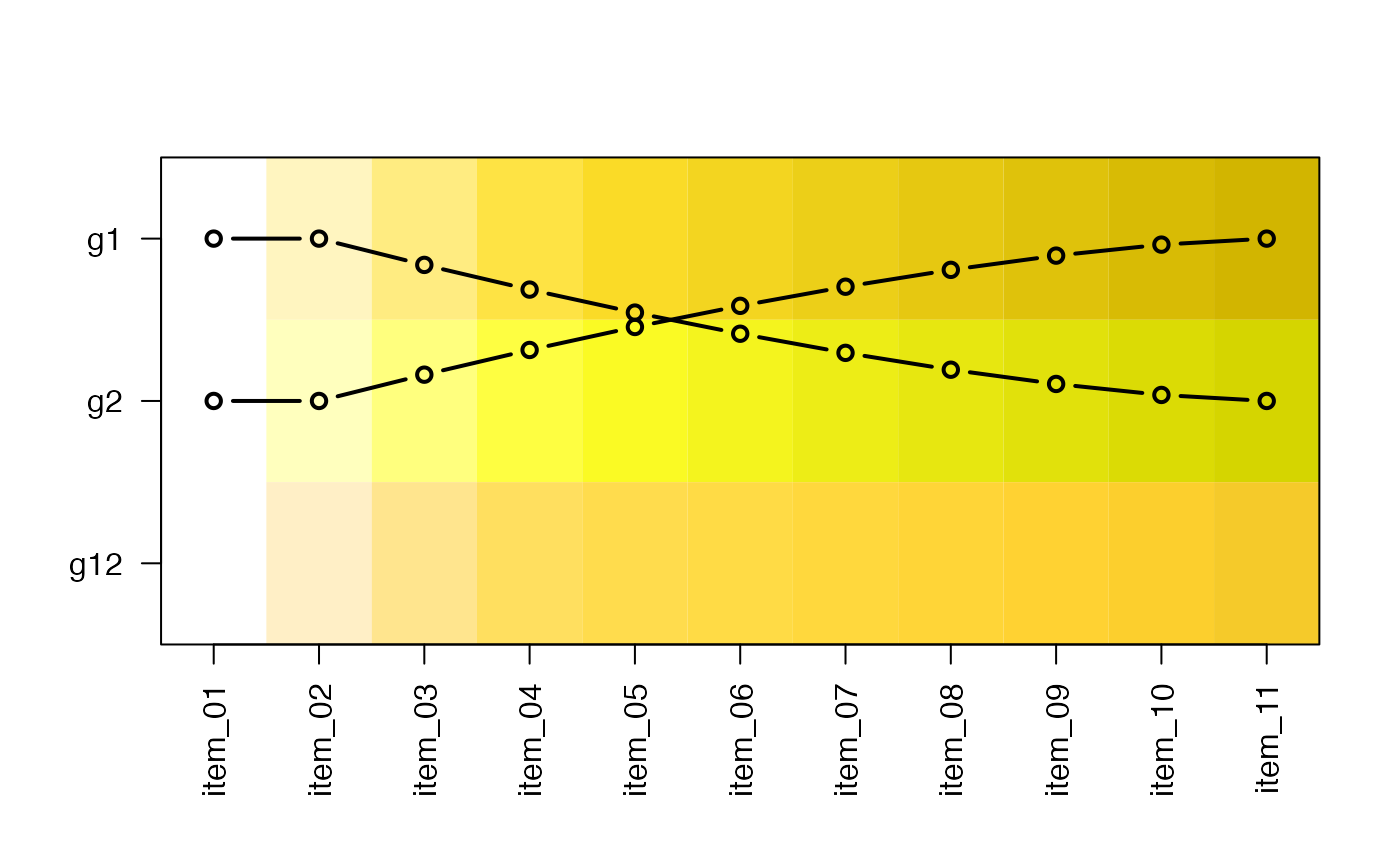 ts1 <- twostep_gradient("orange2", "firebrick", n=11, debug=TRUE)
#> w1 w2
#> 1 1.00000000 0.0000000
#> 2 1.00000000 0.0000000
#> 3 0.83805248 0.1619475
#> 4 0.68593553 0.3140645
#> 5 0.54433105 0.4556689
#> 6 0.41408666 0.5859133
#> 7 0.29629630 0.7037037
#> 8 0.19245009 0.8075499
#> 9 0.10475656 0.8952434
#> 10 0.03703704 0.9629630
#> 11 0.00000000 1.0000000
ts1 <- twostep_gradient("orange2", "firebrick", n=11, debug=TRUE)
#> w1 w2
#> 1 1.00000000 0.0000000
#> 2 1.00000000 0.0000000
#> 3 0.83805248 0.1619475
#> 4 0.68593553 0.3140645
#> 5 0.54433105 0.4556689
#> 6 0.41408666 0.5859133
#> 7 0.29629630 0.7037037
#> 8 0.19245009 0.8075499
#> 9 0.10475656 0.8952434
#> 10 0.03703704 0.9629630
#> 11 0.00000000 1.0000000
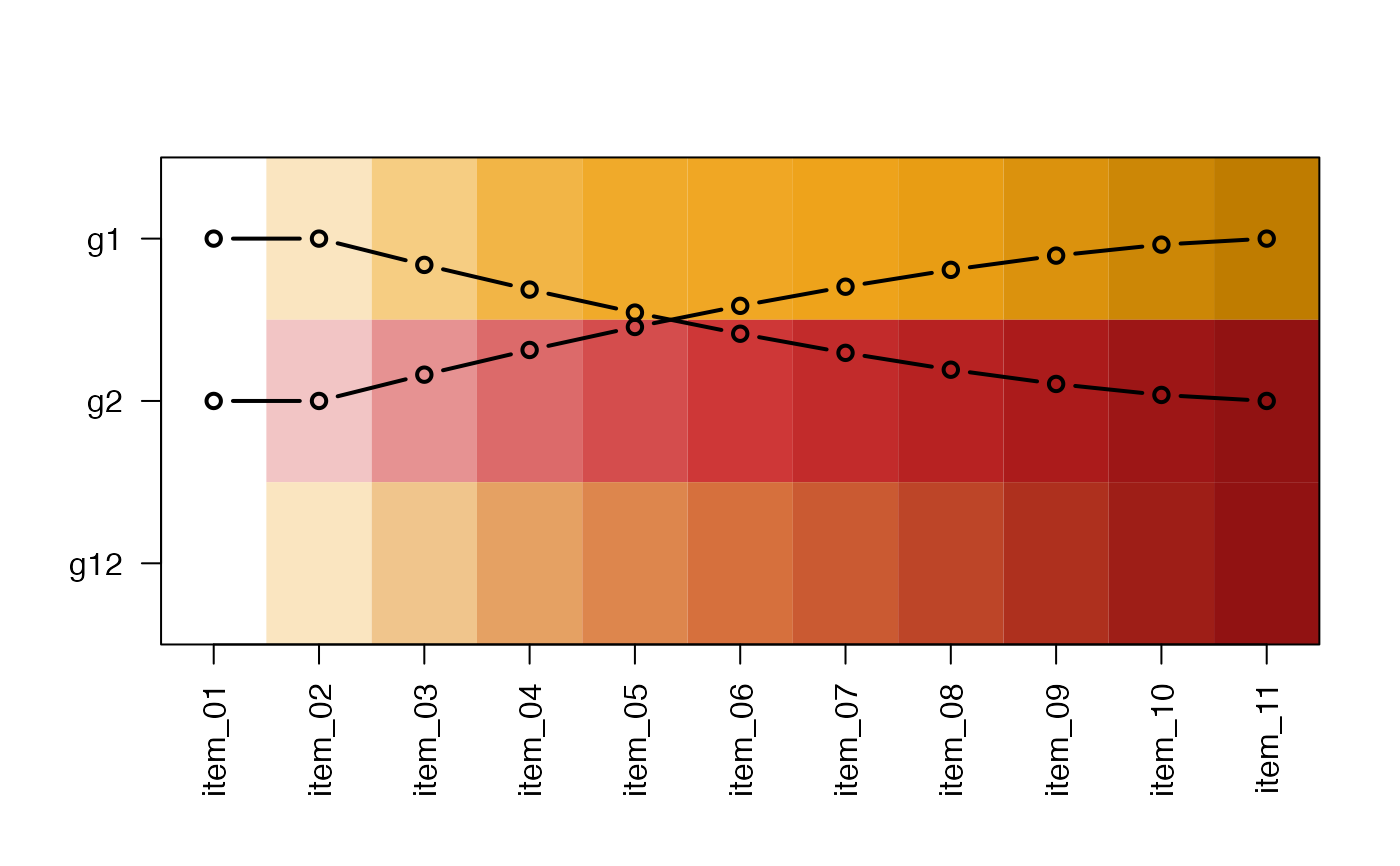 ts2 <- twostep_gradient("aquamarine", "dodgerblue", n=11, debug=TRUE)
#> w1 w2
#> 1 1.00000000 0.0000000
#> 2 1.00000000 0.0000000
#> 3 0.83805248 0.1619475
#> 4 0.68593553 0.3140645
#> 5 0.54433105 0.4556689
#> 6 0.41408666 0.5859133
#> 7 0.29629630 0.7037037
#> 8 0.19245009 0.8075499
#> 9 0.10475656 0.8952434
#> 10 0.03703704 0.9629630
#> 11 0.00000000 1.0000000
ts2 <- twostep_gradient("aquamarine", "dodgerblue", n=11, debug=TRUE)
#> w1 w2
#> 1 1.00000000 0.0000000
#> 2 1.00000000 0.0000000
#> 3 0.83805248 0.1619475
#> 4 0.68593553 0.3140645
#> 5 0.54433105 0.4556689
#> 6 0.41408666 0.5859133
#> 7 0.29629630 0.7037037
#> 8 0.19245009 0.8075499
#> 9 0.10475656 0.8952434
#> 10 0.03703704 0.9629630
#> 11 0.00000000 1.0000000
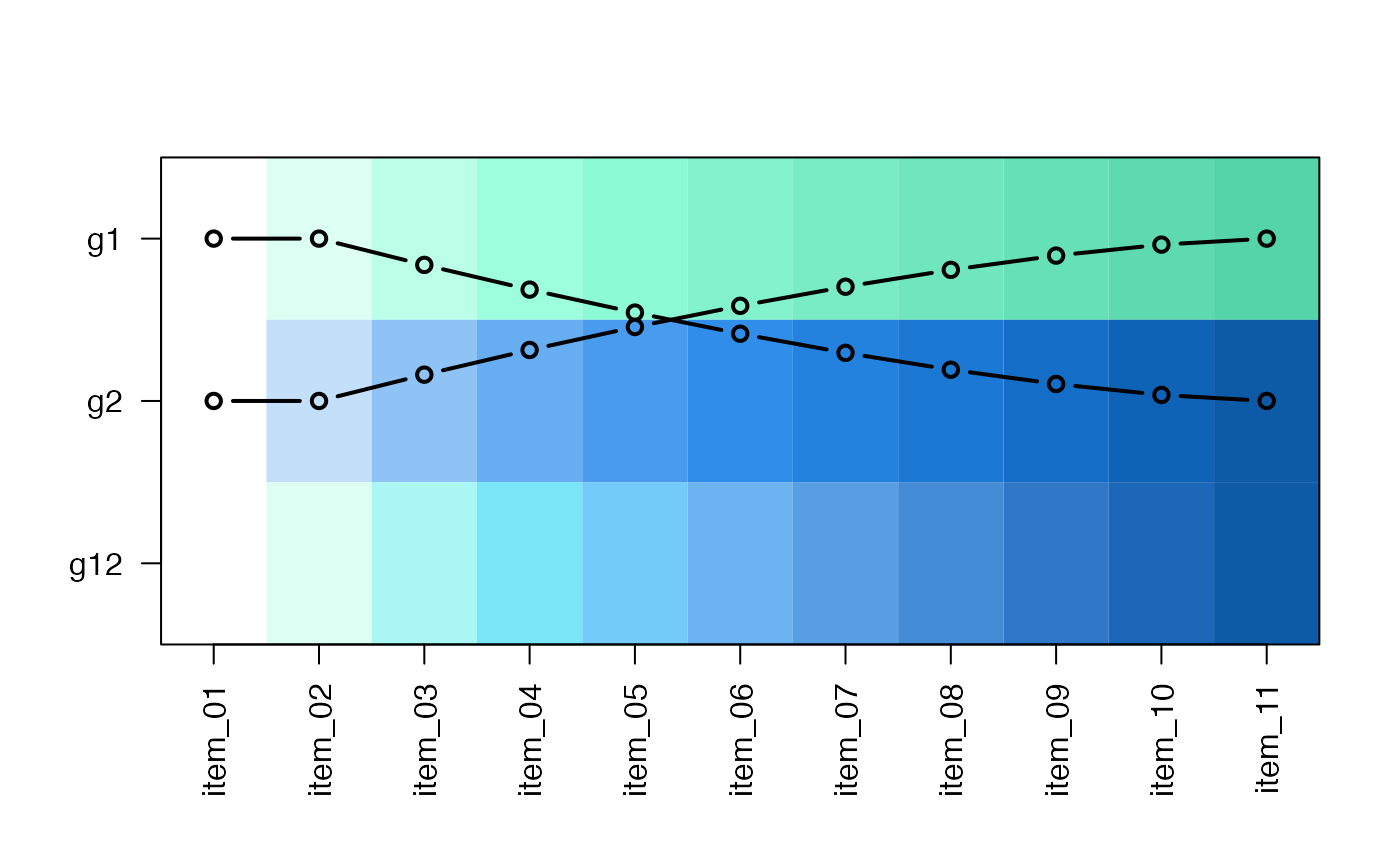 # stitch them together with make_jam_divergent()
ts1ts2 <- make_jam_divergent(list(ts2=ts2), list(ts1=ts1), n=21)
jamba::showColors(ts1ts2)
# stitch them together with make_jam_divergent()
ts1ts2 <- make_jam_divergent(list(ts2=ts2), list(ts1=ts1), n=21)
jamba::showColors(ts1ts2)
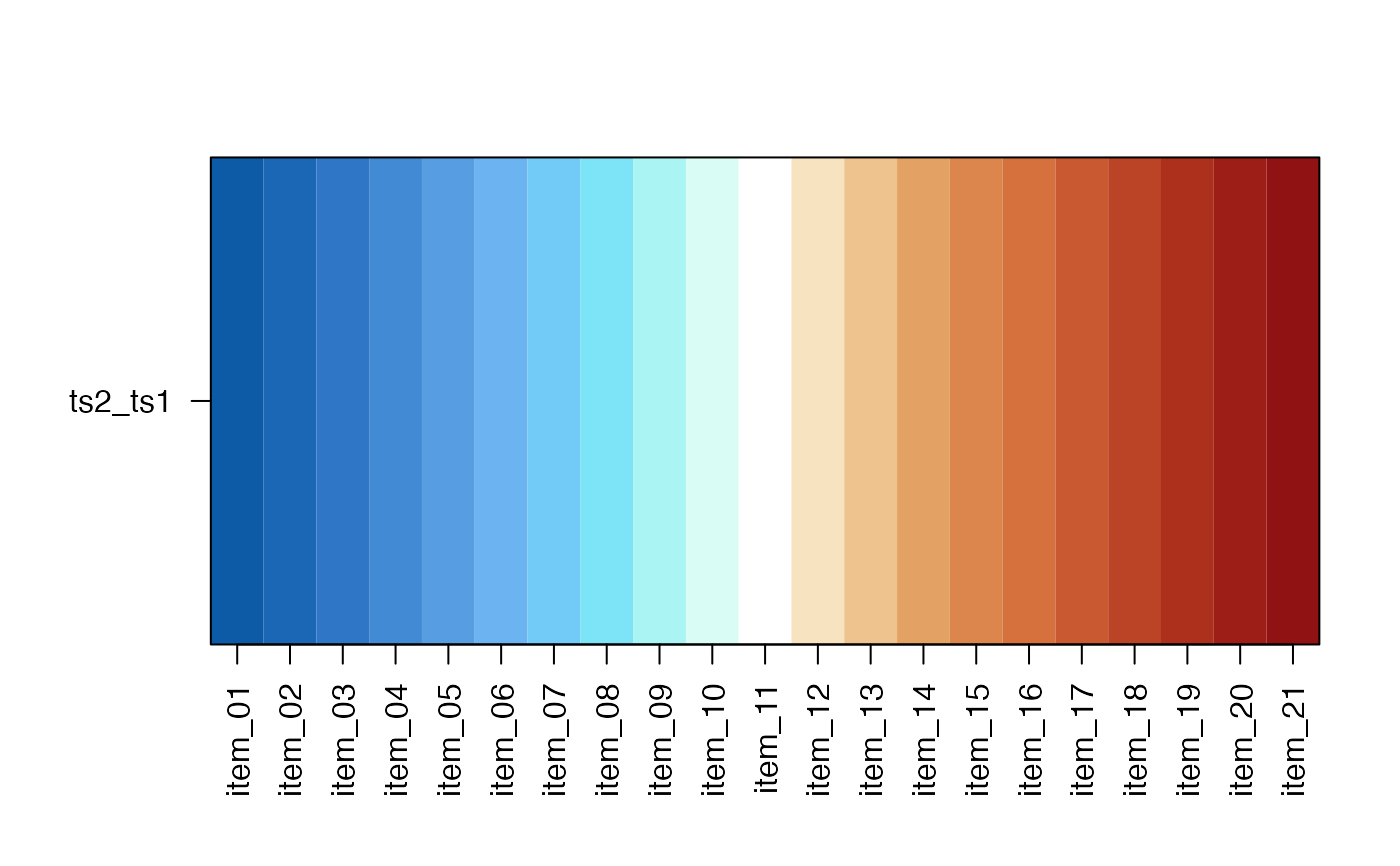 ts1ts2flat <- make_jam_divergent("dodgerblue", "firebrick", n=21)
jamba::showColors(list(
twostep=ts1ts2[[1]],
flat=ts1ts2flat[[1]]))
ts1ts2flat <- make_jam_divergent("dodgerblue", "firebrick", n=21)
jamba::showColors(list(
twostep=ts1ts2[[1]],
flat=ts1ts2flat[[1]]))
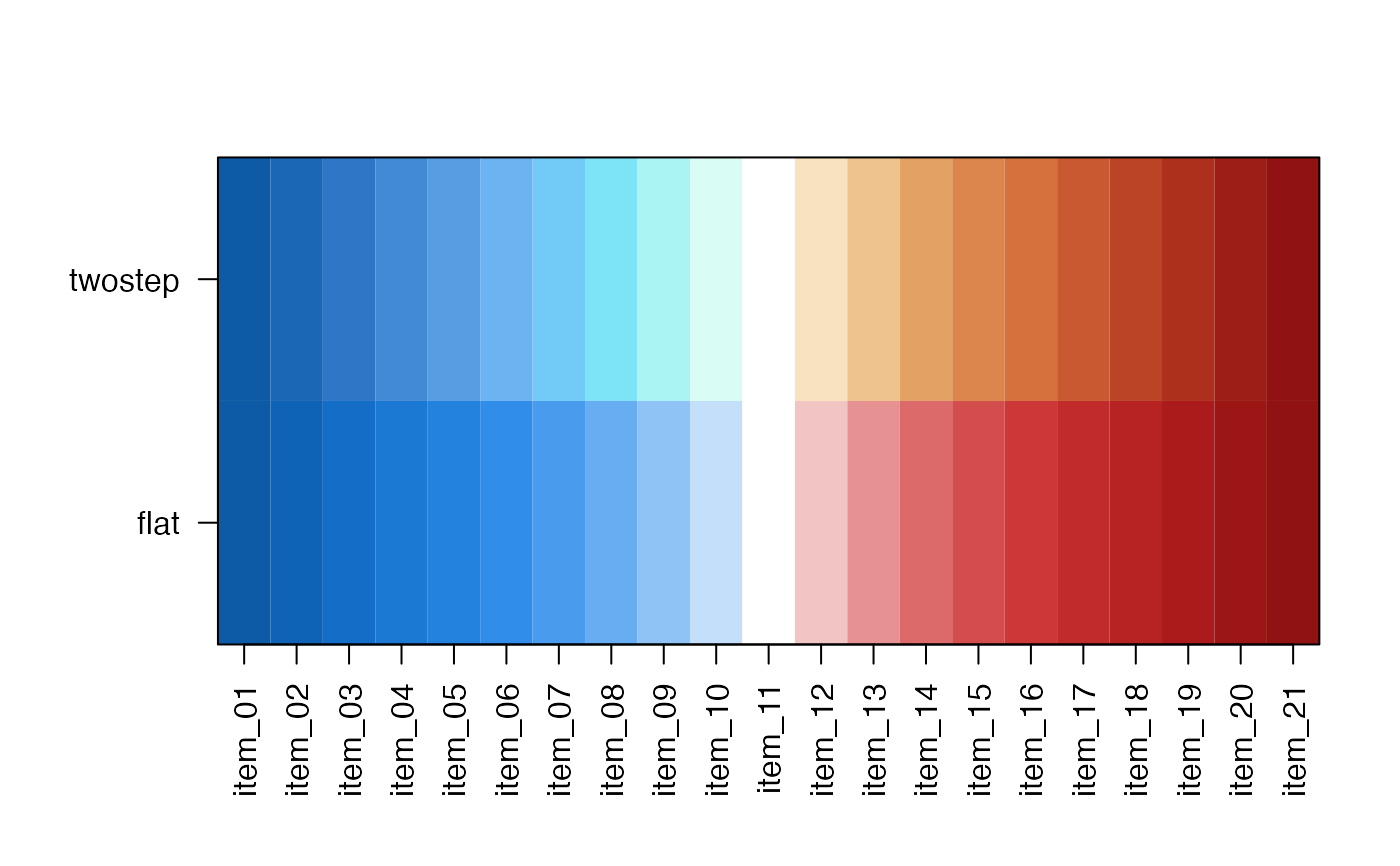 ts3 <- twostep_gradient("Greens", "Blues", n=11, debug=TRUE)
#> w1 w2
#> 1 1.00000000 0.0000000
#> 2 1.00000000 0.0000000
#> 3 0.83805248 0.1619475
#> 4 0.68593553 0.3140645
#> 5 0.54433105 0.4556689
#> 6 0.41408666 0.5859133
#> 7 0.29629630 0.7037037
#> 8 0.19245009 0.8075499
#> 9 0.10475656 0.8952434
#> 10 0.03703704 0.9629630
#> 11 0.00000000 1.0000000
ts3 <- twostep_gradient("Greens", "Blues", n=11, debug=TRUE)
#> w1 w2
#> 1 1.00000000 0.0000000
#> 2 1.00000000 0.0000000
#> 3 0.83805248 0.1619475
#> 4 0.68593553 0.3140645
#> 5 0.54433105 0.4556689
#> 6 0.41408666 0.5859133
#> 7 0.29629630 0.7037037
#> 8 0.19245009 0.8075499
#> 9 0.10475656 0.8952434
#> 10 0.03703704 0.9629630
#> 11 0.00000000 1.0000000
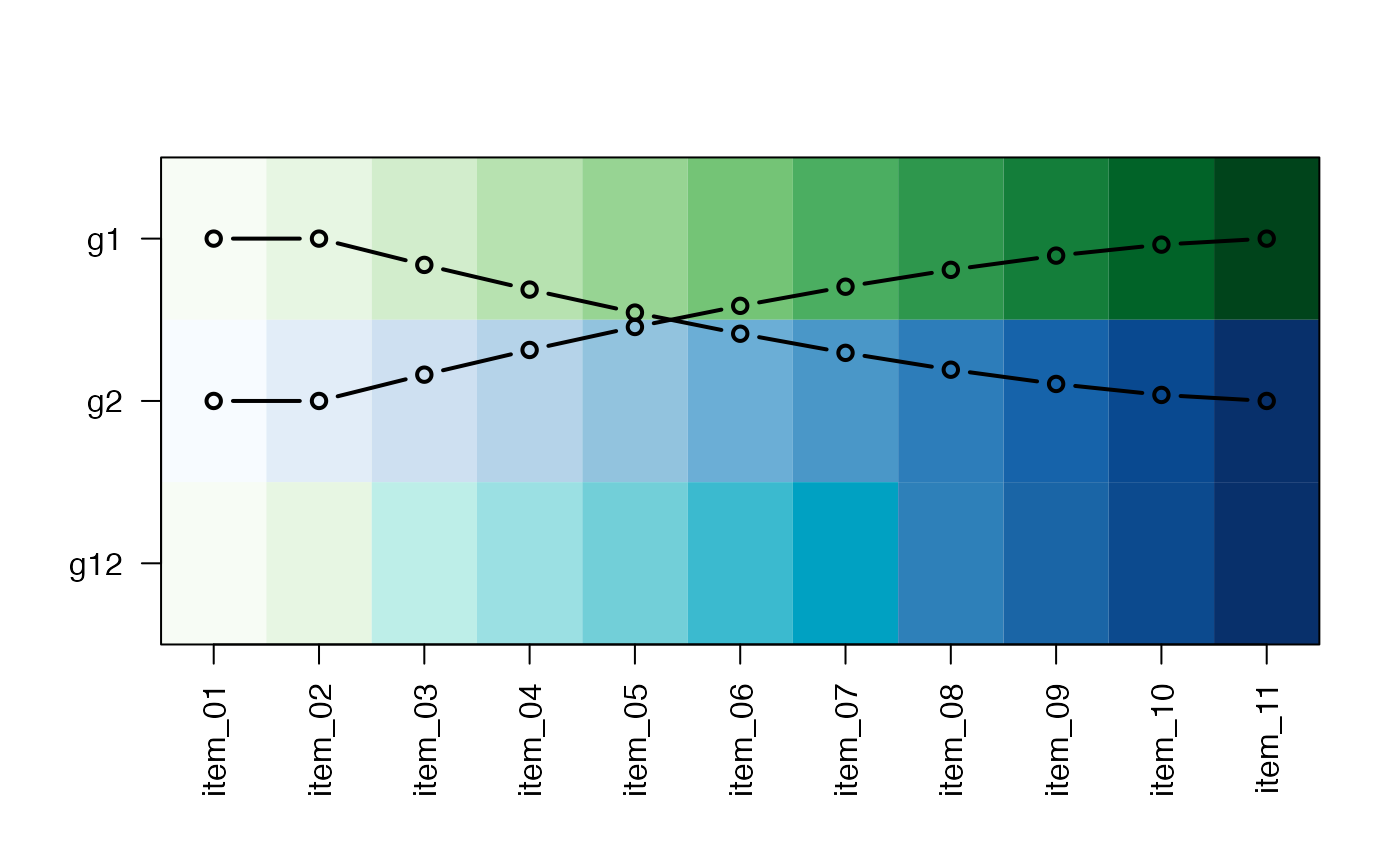 ts4 <- twostep_gradient("slateblue2", "firebrick", n=11, debug=TRUE)
#> w1 w2
#> 1 1.00000000 0.0000000
#> 2 1.00000000 0.0000000
#> 3 0.83805248 0.1619475
#> 4 0.68593553 0.3140645
#> 5 0.54433105 0.4556689
#> 6 0.41408666 0.5859133
#> 7 0.29629630 0.7037037
#> 8 0.19245009 0.8075499
#> 9 0.10475656 0.8952434
#> 10 0.03703704 0.9629630
#> 11 0.00000000 1.0000000
ts4 <- twostep_gradient("slateblue2", "firebrick", n=11, debug=TRUE)
#> w1 w2
#> 1 1.00000000 0.0000000
#> 2 1.00000000 0.0000000
#> 3 0.83805248 0.1619475
#> 4 0.68593553 0.3140645
#> 5 0.54433105 0.4556689
#> 6 0.41408666 0.5859133
#> 7 0.29629630 0.7037037
#> 8 0.19245009 0.8075499
#> 9 0.10475656 0.8952434
#> 10 0.03703704 0.9629630
#> 11 0.00000000 1.0000000
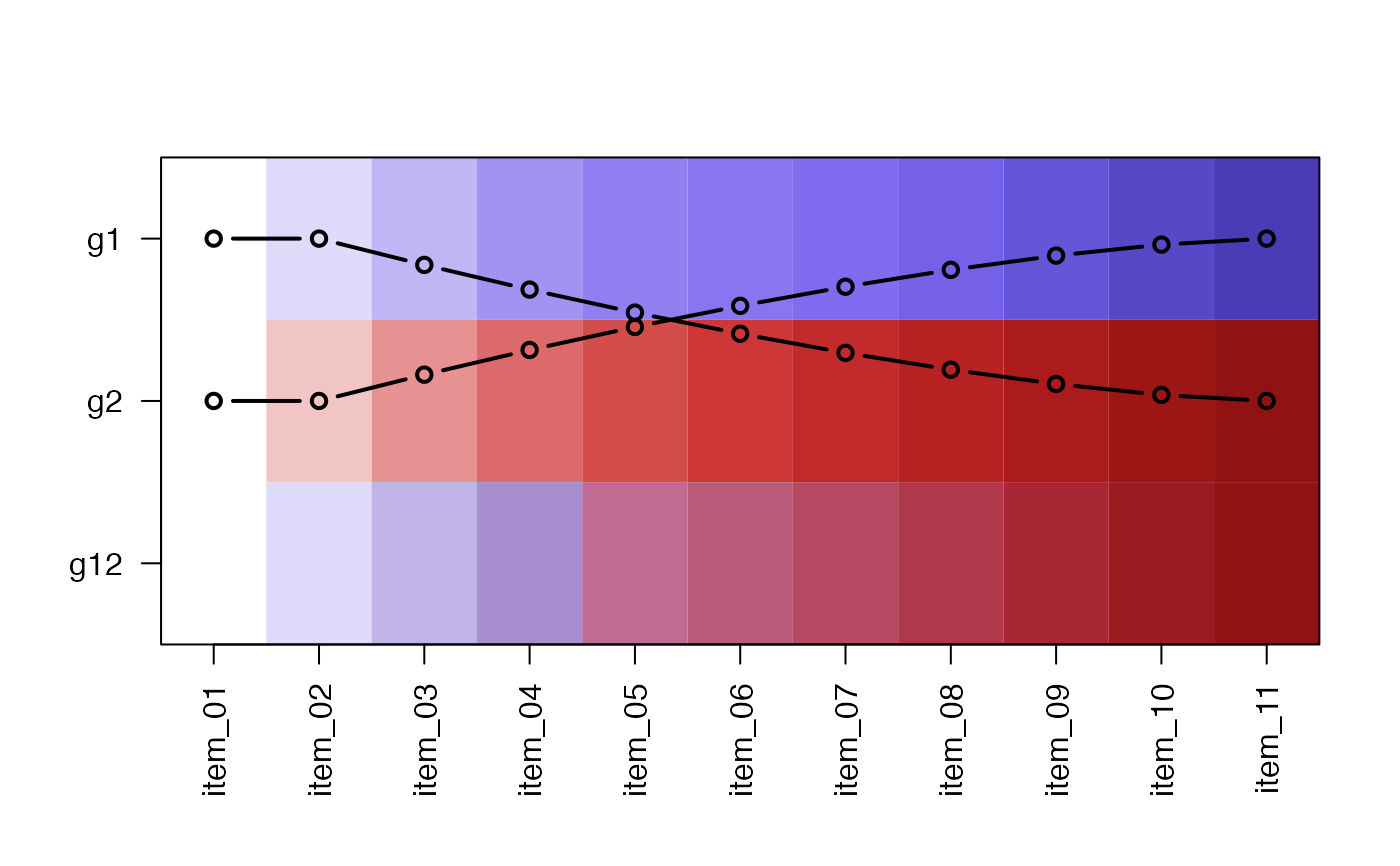 ts5 <- twostep_gradient("cividis", "inferno", n=11, debug=TRUE, adjust=-1.2)
#> w1 w2
#> 1 1.0000000 0.00000000
#> 2 1.0000000 0.00000000
#> 3 0.9065106 0.09348938
#> 4 0.8110475 0.18895253
#> 5 0.7132755 0.28672454
#> 6 0.6127353 0.38726468
#> 7 0.5087619 0.49123811
#> 8 0.4003123 0.59968768
#> 9 0.2855330 0.71446705
#> 10 0.1602500 0.83975005
#> 11 0.0000000 1.00000000
ts5 <- twostep_gradient("cividis", "inferno", n=11, debug=TRUE, adjust=-1.2)
#> w1 w2
#> 1 1.0000000 0.00000000
#> 2 1.0000000 0.00000000
#> 3 0.9065106 0.09348938
#> 4 0.8110475 0.18895253
#> 5 0.7132755 0.28672454
#> 6 0.6127353 0.38726468
#> 7 0.5087619 0.49123811
#> 8 0.4003123 0.59968768
#> 9 0.2855330 0.71446705
#> 10 0.1602500 0.83975005
#> 11 0.0000000 1.00000000
 gr1 <- twostep_gradient("slateblue", "purple", debug=TRUE)
#> w1 w2
#> 1 1.00000000 0.0000000
#> 2 1.00000000 0.0000000
#> 3 0.83805248 0.1619475
#> 4 0.68593553 0.3140645
#> 5 0.54433105 0.4556689
#> 6 0.41408666 0.5859133
#> 7 0.29629630 0.7037037
#> 8 0.19245009 0.8075499
#> 9 0.10475656 0.8952434
#> 10 0.03703704 0.9629630
#> 11 0.00000000 1.0000000
gr1 <- twostep_gradient("slateblue", "purple", debug=TRUE)
#> w1 w2
#> 1 1.00000000 0.0000000
#> 2 1.00000000 0.0000000
#> 3 0.83805248 0.1619475
#> 4 0.68593553 0.3140645
#> 5 0.54433105 0.4556689
#> 6 0.41408666 0.5859133
#> 7 0.29629630 0.7037037
#> 8 0.19245009 0.8075499
#> 9 0.10475656 0.8952434
#> 10 0.03703704 0.9629630
#> 11 0.00000000 1.0000000
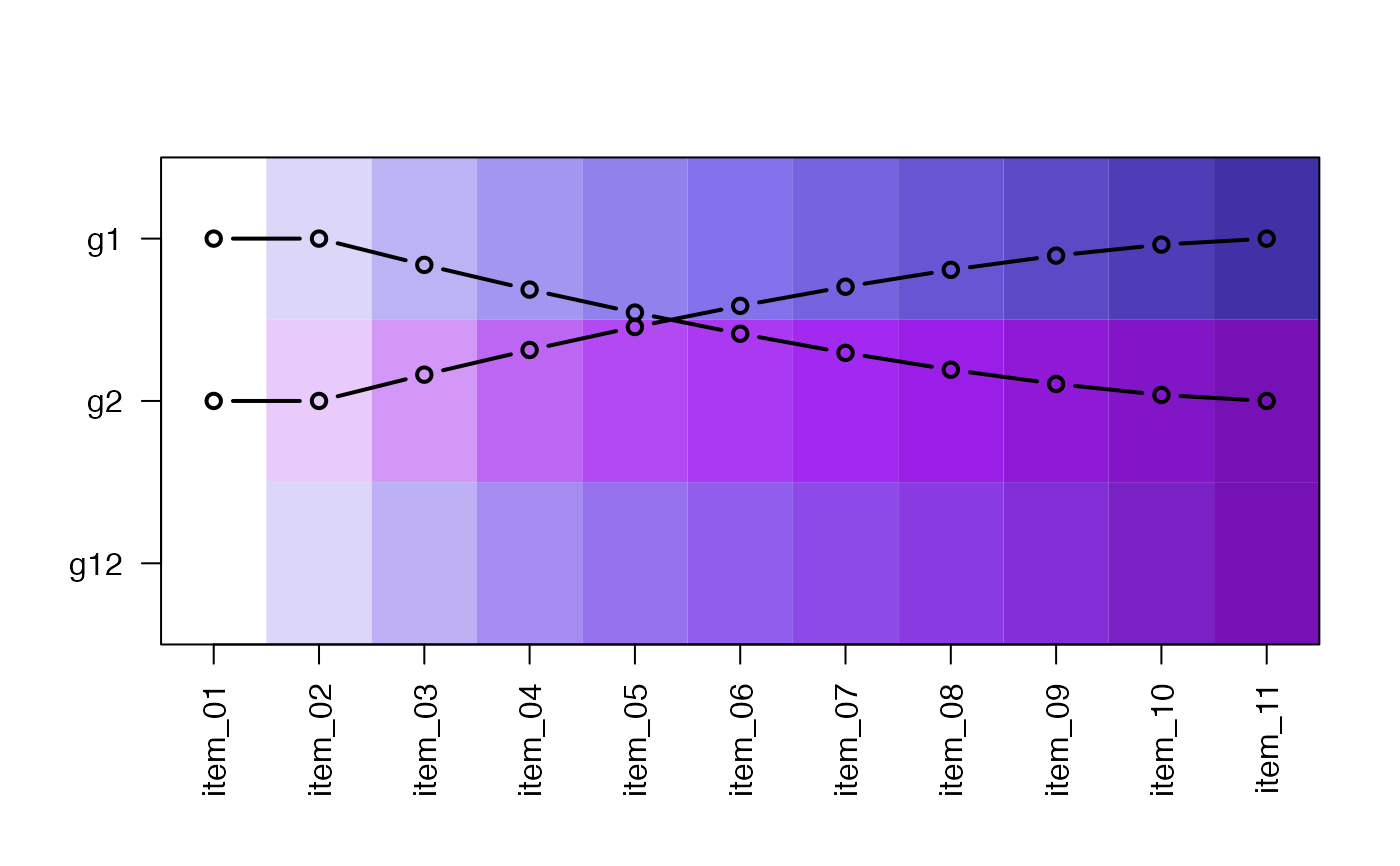 gr2 <- twostep_gradient("gold", "darkorange", debug=TRUE)
#> w1 w2
#> 1 1.00000000 0.0000000
#> 2 1.00000000 0.0000000
#> 3 0.83805248 0.1619475
#> 4 0.68593553 0.3140645
#> 5 0.54433105 0.4556689
#> 6 0.41408666 0.5859133
#> 7 0.29629630 0.7037037
#> 8 0.19245009 0.8075499
#> 9 0.10475656 0.8952434
#> 10 0.03703704 0.9629630
#> 11 0.00000000 1.0000000
gr2 <- twostep_gradient("gold", "darkorange", debug=TRUE)
#> w1 w2
#> 1 1.00000000 0.0000000
#> 2 1.00000000 0.0000000
#> 3 0.83805248 0.1619475
#> 4 0.68593553 0.3140645
#> 5 0.54433105 0.4556689
#> 6 0.41408666 0.5859133
#> 7 0.29629630 0.7037037
#> 8 0.19245009 0.8075499
#> 9 0.10475656 0.8952434
#> 10 0.03703704 0.9629630
#> 11 0.00000000 1.0000000
 div12 <- make_jam_divergent(list(gr1=gr1), list(gr2=gr2))
jamba::showColors(div12)
div12 <- make_jam_divergent(list(gr1=gr1), list(gr2=gr2))
jamba::showColors(div12)
 div12flat <- make_jam_divergent("purple", "gold")
jamba::showColors(list(
twostep=div12[[1]],
flat=div12flat[[1]]))
div12flat <- make_jam_divergent("purple", "gold")
jamba::showColors(list(
twostep=div12[[1]],
flat=div12flat[[1]]))
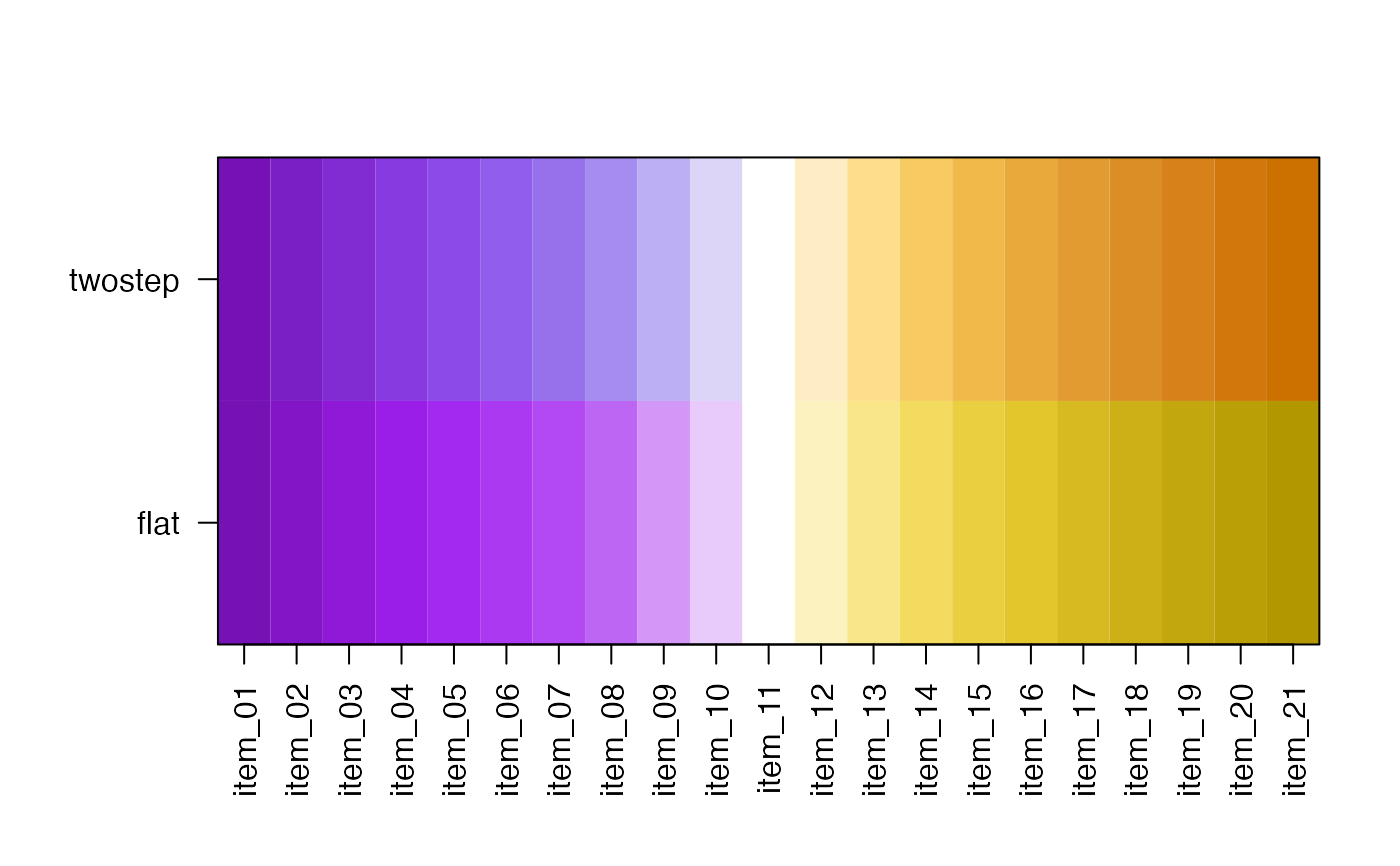 gr1d <- twostep_gradient("slateblue1", "purple", debug=TRUE, lite=FALSE)
#> w1 w2
#> 1 1.00000000 0.0000000
#> 2 1.00000000 0.0000000
#> 3 0.83805248 0.1619475
#> 4 0.68593553 0.3140645
#> 5 0.54433105 0.4556689
#> 6 0.41408666 0.5859133
#> 7 0.29629630 0.7037037
#> 8 0.19245009 0.8075499
#> 9 0.10475656 0.8952434
#> 10 0.03703704 0.9629630
#> 11 0.00000000 1.0000000
gr1d <- twostep_gradient("slateblue1", "purple", debug=TRUE, lite=FALSE)
#> w1 w2
#> 1 1.00000000 0.0000000
#> 2 1.00000000 0.0000000
#> 3 0.83805248 0.1619475
#> 4 0.68593553 0.3140645
#> 5 0.54433105 0.4556689
#> 6 0.41408666 0.5859133
#> 7 0.29629630 0.7037037
#> 8 0.19245009 0.8075499
#> 9 0.10475656 0.8952434
#> 10 0.03703704 0.9629630
#> 11 0.00000000 1.0000000
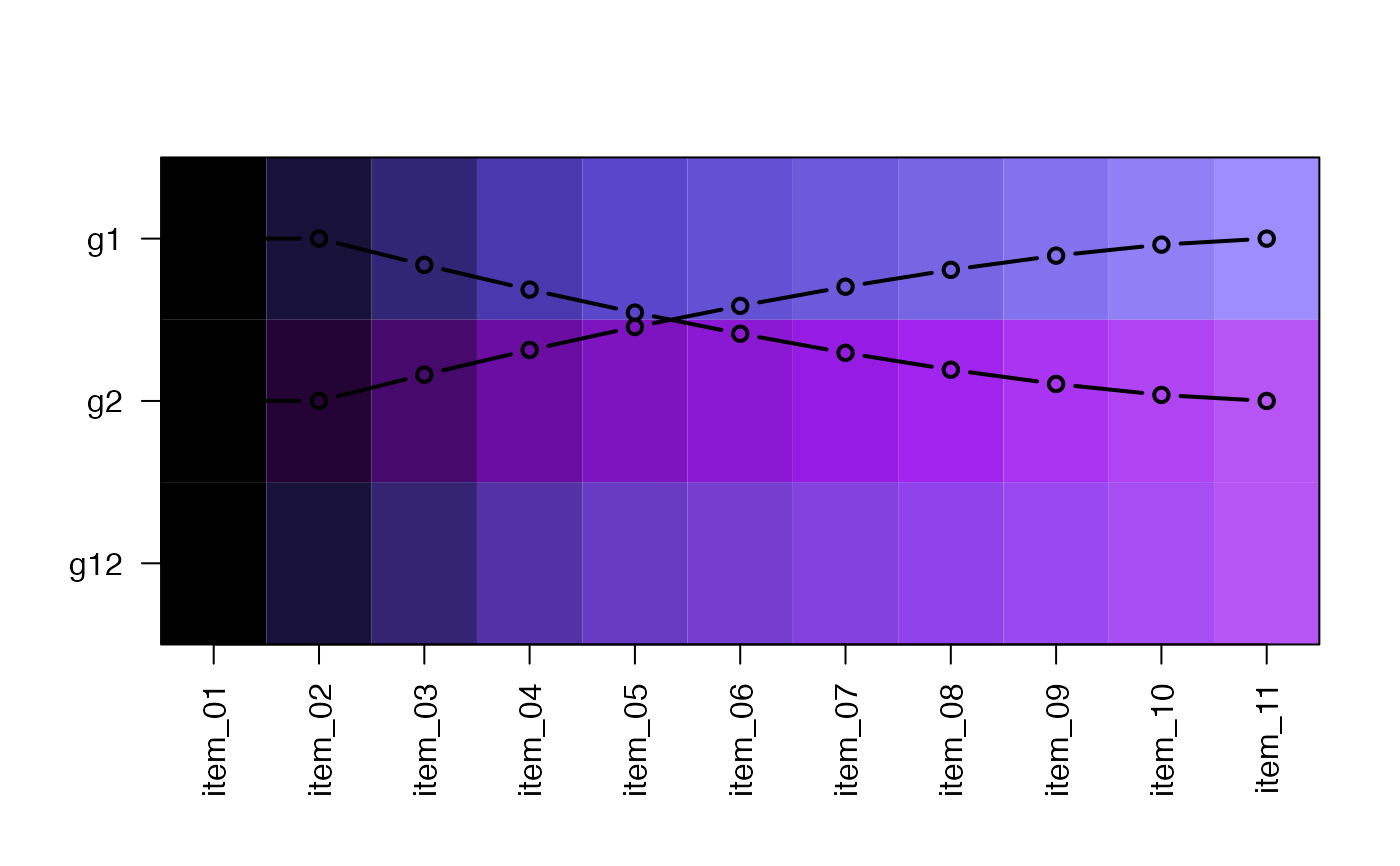 gr2d <- twostep_gradient("darkorange", "gold", debug=TRUE, lite=FALSE)
#> w1 w2
#> 1 1.00000000 0.0000000
#> 2 1.00000000 0.0000000
#> 3 0.83805248 0.1619475
#> 4 0.68593553 0.3140645
#> 5 0.54433105 0.4556689
#> 6 0.41408666 0.5859133
#> 7 0.29629630 0.7037037
#> 8 0.19245009 0.8075499
#> 9 0.10475656 0.8952434
#> 10 0.03703704 0.9629630
#> 11 0.00000000 1.0000000
gr2d <- twostep_gradient("darkorange", "gold", debug=TRUE, lite=FALSE)
#> w1 w2
#> 1 1.00000000 0.0000000
#> 2 1.00000000 0.0000000
#> 3 0.83805248 0.1619475
#> 4 0.68593553 0.3140645
#> 5 0.54433105 0.4556689
#> 6 0.41408666 0.5859133
#> 7 0.29629630 0.7037037
#> 8 0.19245009 0.8075499
#> 9 0.10475656 0.8952434
#> 10 0.03703704 0.9629630
#> 11 0.00000000 1.0000000
 div12d <- make_jam_divergent(list(gr1d=gr1d), list(gr2d=gr2d))
jamba::showColors(div12d)
div12d <- make_jam_divergent(list(gr1d=gr1d), list(gr2d=gr2d))
jamba::showColors(div12d)
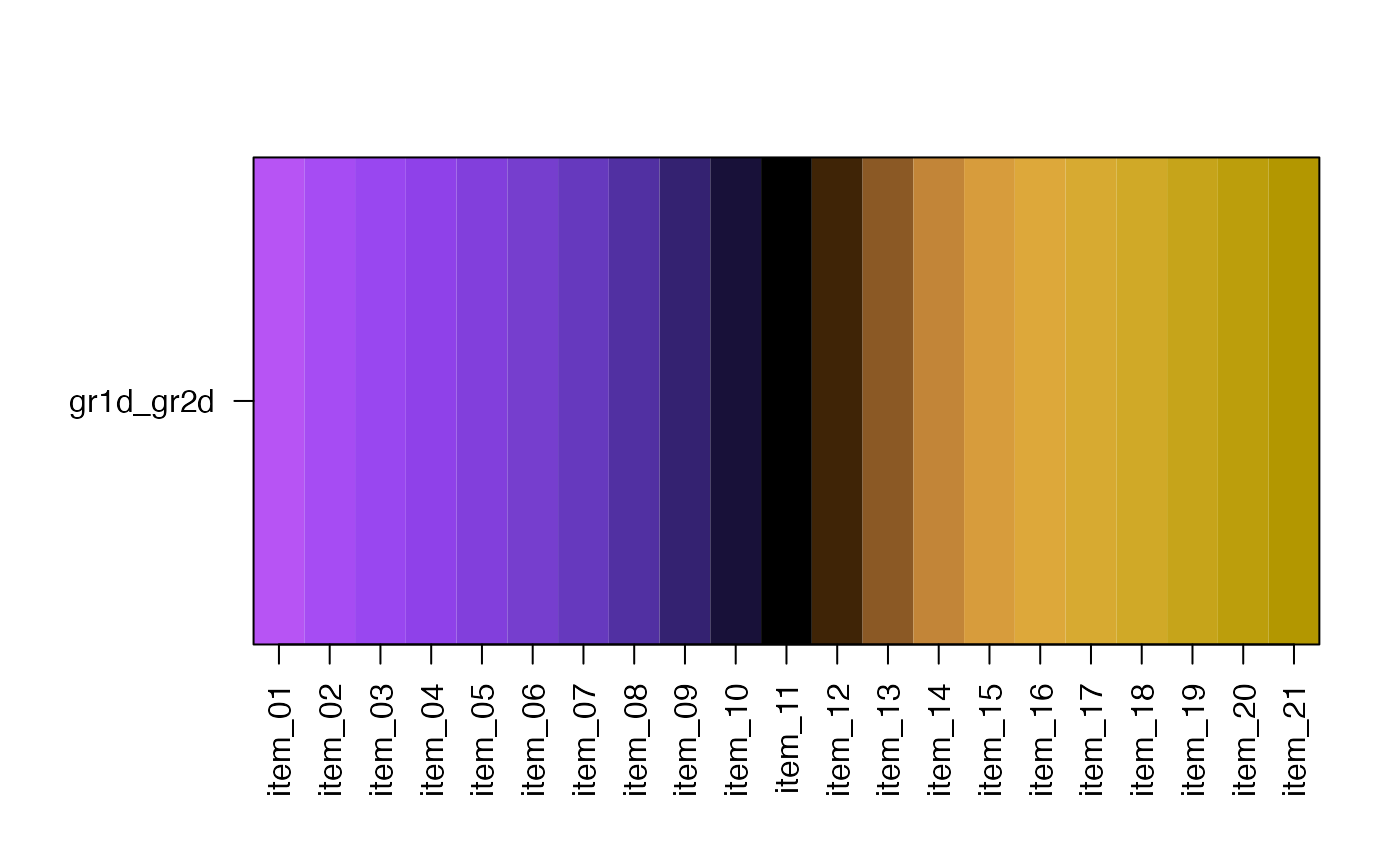 div12dflat <- make_jam_divergent("purple", "gold", lite=FALSE)
jamba::showColors(list(
twostep=div12d[[1]],
flat=div12dflat[[1]]))
div12dflat <- make_jam_divergent("purple", "gold", lite=FALSE)
jamba::showColors(list(
twostep=div12d[[1]],
flat=div12dflat[[1]]))
